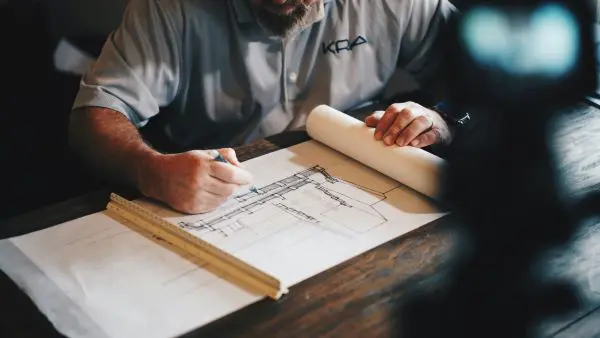What is a Principal Designer?
Posted on: 20 November, 2024

The role of the Principal Designer has been a hotly-debated topic in the built environment. Here’s what it means.
2024 has been a big year for the built environment. With the introduction of the Building Safety Act, the landscape of competencies and responsibilities required for professionals to practice has shifted irrevocably.
While there have been many concerns and discussions about what the Act means for the sector in the long run, one of the biggest talking points has been the emergence of a new role in the design process – the Principal Designer.
But what exactly is this role? Who is responsible for it in a construction project? And what does it mean for the built environment?
What is a Principal Designer?
The Principal Designer is a role in a construction project that is responsible for the planning, managing and coordinating of health and safety during the pre-construction phase of a project. First introduced as part of the Construction (Design and Management) Regulations in 2015, as defined by the Health and Safety Executive a Principal Designer can be an individual or an organisation, and is required in a project involving, or likely to involve, more than one contractor.
With the implementation of the Building Safety Act, the definition of the role has been altered to encompass more responsibility, ownership and accountability.
What is the role of a Principal Designer?
While health and safety risks are more frequently associated with later phases in the building lifecycle, like construction or even operation, the design phase can have a significant impact on whether a project is delivered safely.
Throughout the pre-construction phase, Principal Designers are tasked with identifying risks to health and safety and working closely alongside other teams and functions (as well as the client) to ensure these are addressed in the management of a project.
These individuals or organisations have the ability to make informed decisions in the planning stage, identify potential safety issues, minimise foreseeable risks and optimise elements of the project.
Why the Principal Designer matters now
Even though the concept of this role was introduced back in 2015, it’s taken centre stage once again thanks to the Building Safety Act, where it’s seen as a key role within the regulatory framework for construction projects.
In the wake of the Act, this role is now seen as the single point of accountability for building safety, formalising a longstanding role that has traditionally been served by various parties and often neglected in the building lifecycle. The implementation of this position is a chance for safety to be embedded in every aspect of a building’s design and every stage of a construction project.
As the Royal Institute of British Architects (RIBA) states, the role ‘forms part of the most important regulatory change in the industry since the 1980s,’ and one of the most significant updates to come in the wake of the Grenfell Tower fire.
What are the responsibilities of the Principal Designer?
As stated in the Building Safety Act, this role has various responsibilities:
- Planning, managing, monitoring and coordinating health and safety
- Reviewing relevant information such as health and safety files
- Advising clients in the collation of pre-construction information and ensuring design teams and contractors have all the information they need
- Eliminating or minimising foreseeable risks to anyone affected by a design or project
- Joining design review meetings and monitoring progress
- Encouraging collaboration among everyone in the project team involved in the pre-construction phase
- Maintaining communications with the Principal Contractor and keeping them informed of any potential risks that have been identified
What competencies and qualifications are required for this role?
The ideal candidate to fill this role should have the following capabilities:
- An understanding of building regulations and law
- The ability to lead a design team
- Design experience and knowledge
- Technical knowledge of the design and planning phase
In terms of qualifications, there are many courses and continued professional development (CPD) training options aimed at professionals who want to step into this role.
So who is the Principal Designer?
As with much of the Building Safety Act, the establishment of this role has been met with a mixed reception. Many see it as exactly what the construction industry has been asking for, while others have debated who the role actually belongs to, and questioned whether architects should step into this role and take on yet more responsibility.
 As Marc Fleming, Programme Leader for UCEM’s BSc (Hons) Architectural Design Technology, commented:
As Marc Fleming, Programme Leader for UCEM’s BSc (Hons) Architectural Design Technology, commented:
“Now that the principal designer competency framework is established from PAS 8671, it’s evident that chartered architectural technologists can play a significant role in supporting the objectives of it. The Chartered Institute of Architectural Technologists’ (CIAT) Principal Designer register gives the architectural design technology professionals an opportunity to lead the way with other allied professions in ensuring optimised building safety.”
“From managing the golden thread to technical, legislative and design compliance, chartered architectural technologists have the expertise and versatility to deliver to the standards, making it an exciting time for the profession to be part of an industry that is transforming approaches to building safety.”
View CIAT’s Principal Designer register: https://architecturaltechnology.com/resources/building-safety-hub/principal-designer.html
Read CIAT’s recommendations for architectural technology professionals following the final Grenfell Tower report: https://www.pbctoday.co.uk/news/building-control-news/ciat-briefing-recommendations-architects-post-grenfell/144720/





